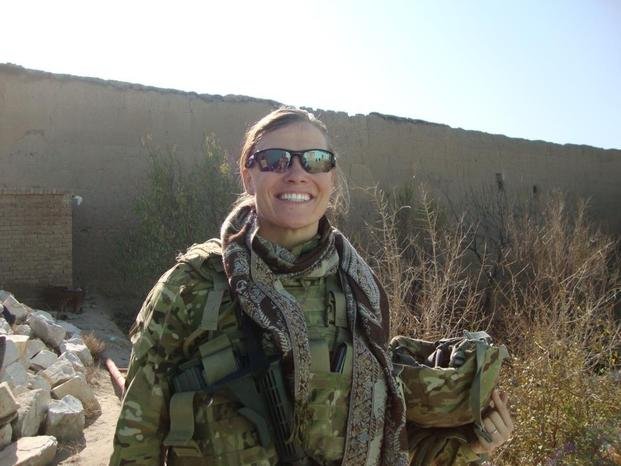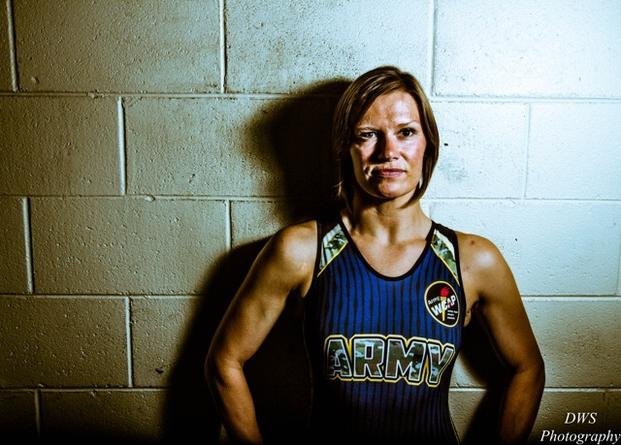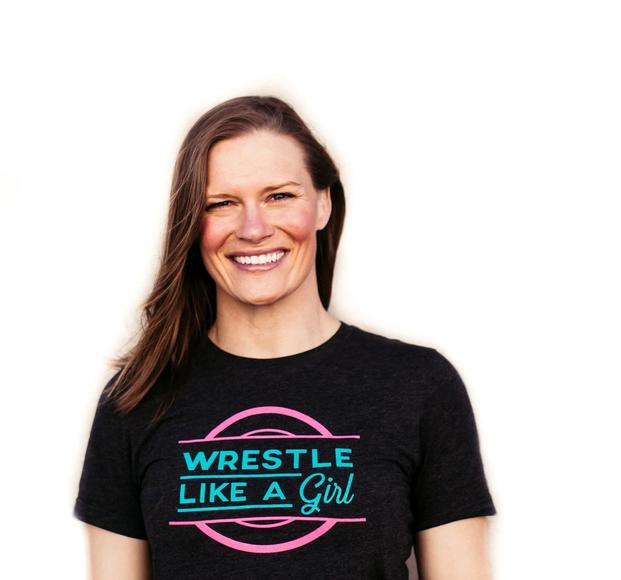Sally Roberts did not intend to lose. Faced with a chance to make the U.S. Olympic team for women’s wrestling and clinch a spot in the 2008 Summer Olympics, Roberts battled valiantly, but eventually bowed out, falling to her opponent in a best two-out-of-three falls match.
What to do?
Roberts was lost. She didn’t know what to do next. She had prepared for this moment for several years, grunting through early-morning workouts and pressure-packed bouts at national and world competitions. Roberts decided she needed another challenge. A shift in her life to pull her out of her funk.
She signed up for the U.S. Army.
Roberts spent six years in active duty and was deployed to Afghanistan from 2012-2013. She served as a 37 Fox, psychological operations specialist, using “influential messaging to engage and influence targeted audiences.”
When she returned home from Afghanistan, Roberts wrestled for the Army’s World Class Athlete Program. In 2016, she co-founded Wrestle Like a Girl, a non-profit organization working to advance girls' and women’s wrestling across the globe. In nine short years, Wrestle Like a Girl has sparked 41 states in the U.S. to recognize girls’ wrestling as a varsity sport, Roberts said. At the collegiate level, earlier this year, women’s wrestling became the NCAA’s 91st championship sport, with the first national championship tournament scheduled for 2026.
More recently, Roberts weighed in on Secretary of War Pete Hegseth’s controversial comments about the military adapting a “new male standard” for physical fitness. While some women veterans scoffed at Hegseth’s remark, Roberts embraced it, saying the new mandates create a “pathway to fairness” for all troops.
Roberts, a two-time world bronze medalist and a three-time national champion, joined Military.com recently for an interview to discuss a variety of topics, including her deployment to Afghanistan, advocating for more opportunities for women, and what the future holds for female wrestling.

Kevin Damask (KD): Why were you interested in joining the military?
Sally Roberts (SR): In 2008, we would be competing in Beijing, China, in the Summer Olympics. I had planned and prepared to make that Olympic team. I didn’t. I lost in the (Olympic qualifying) finals in a best two-out-of-three falls match.
Because I didn’t prepare to lose, I didn’t have anything lined up and realized that pretty quickly, if I didn’t find something to do, I could fall into that dark abyss of depression. I knew that if I didn’t change my physical space, my mental space wouldn’t change, so I made the decision to go to the Army recruiter, enlist, and let my future go from there.
KD: What specifically was your role in Special Operations?
SR: I did a few different things. Perhaps the most notable is that I would go on missions with other entities. I would go out with a female interpreter, and we would talk to other women in the countryside of Afghanistan. We would collect that info and report it back to the commander, and start to paint a picture of the landscape as it existed from both the male and female perspectives over there.
KD: Did you volunteer to go to Afghanistan?
SR: I did. They were asking for volunteers for deployment, and I was raising my hand. I kept getting passed over, and I wasn’t sure why, so I jumped up on a chair and started jumping up and down, making it so obvious that I wanted to go. I was fortunate to get that opportunity.
KD: Why volunteer to be deployed to a war zone when you know there’s going to be dangerous challenges?
SR: I welcomed whatever path was going to unfold in front of me. I also realized there was going to be danger and challenge, and because of the space I was in, which was heartbreak from not making the Olympic team. Sometimes service members join because they’re running from something or running to something. For me, it was a combination of both. I looked forward to understanding who I was out of the athletic arena, so I made a decision when I was on the “bird” traveling over to a war zone, I said, “God, there might be a chance I want to come back to the U.S. and wrestle, so if you can throw some adversity at me, and I can really understand it at a different level, I would be really grateful.”
I learned really quickly that going to war, you never ask God for that very specific thing.
KD: Secretary of War Pete Hegseth made the comment at his address to senior military officers that there would be a “new male standard” all military personnel would have to adhere to. The comment definitely caused controversy with some female veterans saying it didn’t really make sense, since there’s never been a separate “female standard.” But you said his plan was something you could get behind because you had been denied performing certain physical tasks in the Army. Can you expand on that?
SR: From my experience, I welcomed the opportunity to suffer. I found joy in it. I loved the opportunity to find my joy in suffering and fight my way through to the other side. I really looked at it as an elite athlete and a service member. They’re very intertwined with psychology – what do we have to do to be our best? What is it going to take?
Historically, has there been a female standard? Yes. It’s far below that of the male standard, and this is for roles across the military. We never cared what the lowest standard was or what the passing standard was for women; we wanted to be on par and equal to our male counterparts, and we wanted our male counterparts to be on equal standard with us. So, we looked at it through the lens of what do I need to do to successfully do my job? Also, what do I need to do to be a good teammate and honor the values of the U.S. military and the United States of America?
KD: What was the most rewarding experience you had in the military? On the flip side, what was most challenging?
SR: The most enjoyable aspect, hands down, was the camaraderie, the community that gets built from being not just in the military, but when you’re with your unit and you suffer together, and you create those lasting bonds.
As far as challenges, because of the way my brain works with physical activity, I really wanted to see how far I could push myself. How great could I be? And within the community I was involved with, I was surrounded by like-minded individuals who wanted our team to succeed, who wanted our nation to succeed, and for that to happen, we all needed to be peak performers.
KD: What is your opinion of how the U.S. military pulled out of Afghanistan in the summer of 2021 after a 20-year engagement?
SR: I share the sentiment of many of my brothers and sisters I served with. It was a very hard thing to witness, especially finding out about the Marines who lost their lives on that tragic day. I carried a lot of heaviness, a lot of grief, and the grief for me continues as I look at what’s happening to the women of Afghanistan. They’ve lost their voice. They’ve lost their ability to speak in public. Lost their ability in education. The ability for them to participate in any sports has been obliterated. How everything went down has been devastating.

KD: When did you start Wrestle Like a Girl? What was the catalyst for getting that organization going?
SR: It’s a multipronged question. When I was deployed to Afghanistan and I was on patrol with the Pathfinders, I was with my interpreter, and we were walking and one of the male soldiers I was with said, “Well, would you look at that.” I turned to my left and saw a gaggle of girls, and they looked just like girls in the U.S. They were wearing shorts and T-shirts; their hair was all crazy and they were out playing games. I realized, Wow, this was probably the first time they’ve ever seen a woman in a leadership position. I looked over and smiled, and that was the invitation they needed to rush over. In Afghanistan, they would give you their version of the high-five, which is their thumb touching your thumb. I gave them all these little thumb high-fives.
I realized at that moment that if I wanted to make an impact and be a positive role model for young girls, I didn’t need to go to a war zone to do that, I could do that right here in the U.S. and so that was one of the big pieces, my heart started to shift on how I could be of service.
When I came back from my deployment and I was wrestling for the Army’s World Class Athlete Program, we would go to the sauna after practice, and that’s where we would come up with the best, biggest, and boldest ideas. I was sitting in there, kind of complaining about some of the things happening in our sport, and it hit me, I’m a military service member, I’m a leader, I can do something about it besides being the person who complains. I had this vision that I would start an organization that would be a benefit to girls and women in wrestling.
The third thing that happened was that I was at a youth wrestling tournament. A girl and a boy were wrestling with each other, and the girl beat the boy, and as she was walking off, something was said to her that made her start crying. Her mom brought her over to me, and I said, “You just won that match, why are you crying?” She said, “Well, the boy’s dad said that even though I beat him, it didn’t matter because I wrestled like a girl.” I thought, Wait a minute. I’m a girl and I’m a two-time world bronze medalist, and you’re a girl and you just won that match. So, it seems to me that if he wants to win, he should also wrestle like a girl. In that moment, all three elements came together and blossomed. Wrestle Like a Girl has become the preeminent national and global advocacy program for girls and women in the sport of wrestling.
KD: Female wrestling programs continue to grow in high schools and colleges. How do you see the future of girls' and women’s wrestling?
SR: When we started Wrestle Like a Girl in 2016, 17,000 girls were wrestling in the U.S. Six states recognized girls wrestling as a high school sport. In the short time span of nine years, we are now at over 75,000 girls wrestling; there are 47 states that recognize it as a high school sport. And, starting this year, the NCAA named women’s college wrestling as a championship sport.
We’ve laid the foundation. We’ve opened up the doors of access and opportunity, but we need to keep building. We need to have every state recognize it as a high school sport, and because women’s wrestling is an NCAA championship sport, the drive is to get more Division I institutions to offer women’s wrestling. It’s critical because if you look at where the females are coming from, they are historically from lower socioeconomic classes, and usually, there is some sort of challenge in their background. So, it’s really important for us to reduce those barriers of entry to allow them an affordable education, and that comes with those in-state institutions.
Traditionally, women’s wrestling is in the freestyle form at college programs, whereas men’s wrestling is folkstyle. What that means is you can be a girl from anywhere in the world, and if you can pass your English proficiency exam, you can get accepted into college and be recruited to wrestle. You can come to the U.S., get an education, wrestle, and go back to your home country and represent your country in the Olympics.
Just this year, the country of Jordan sent its first female wrestler to the U.S. to compete in college. It’s proof that if you build it and you build it with the right intention, they will come.
KD: It kind of shows that you’re bringing girls over from other countries, giving them the steps to succeed, hopefully they can take that experience back to their home country, and then they can build programs overseas.

SR: That’s right. Why wrestling? Well, it’s the sport that you don’t have anyone to blame but yourself for how well you perform, and wrestling inherently builds courage, confidence, and character in our leaders. We need stronger leaders who can compete against anyone, anywhere in the world.
Wrestling is critical for girls because it teaches them to own their space, voice, and body. They have to know who they are and what they’re capable of so they can continue to push those limits to greater heights than they could ever fathom possible.
KD: Anything else you would like to add about girls wrestling or just women’s sports in general?
SR: The full inclusion of women is the task of the 21st century. It’s imperative that we give them the opportunity so they can succeed, knowing that our nation is going to succeed and drive into prosperity because we’ve given a voice to the voiceless by providing them an avenue to live their own American dream.















